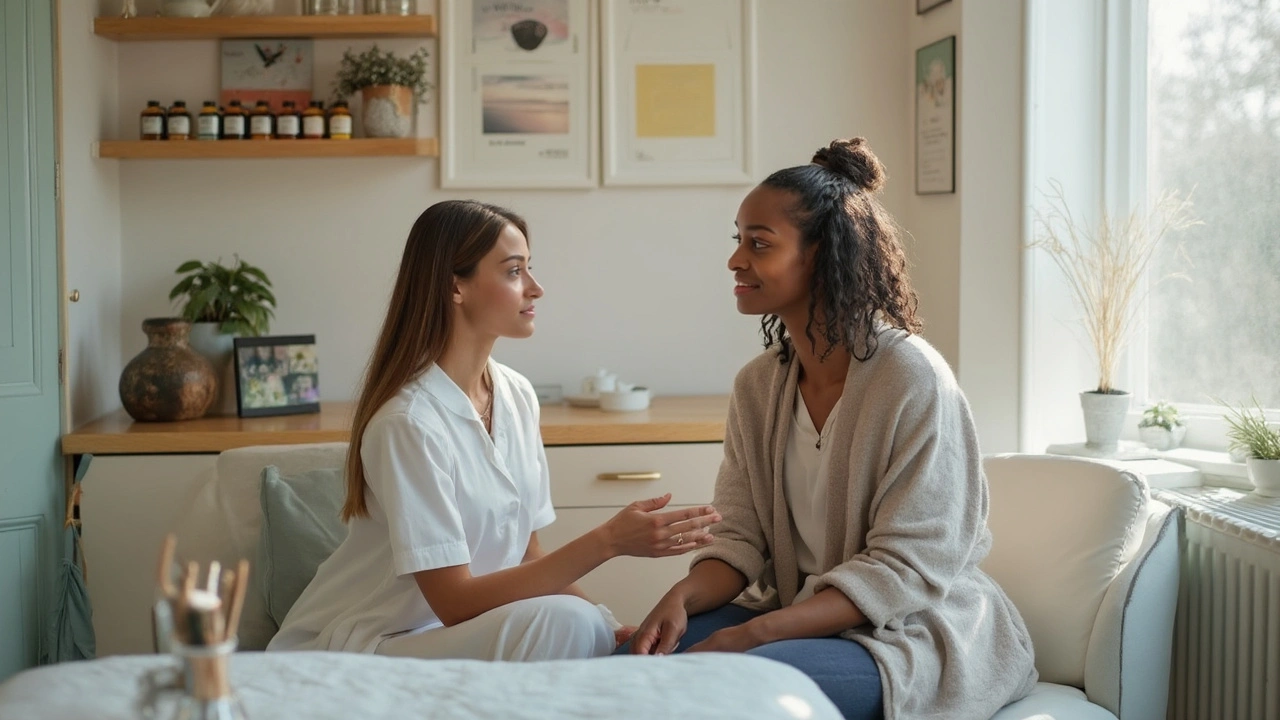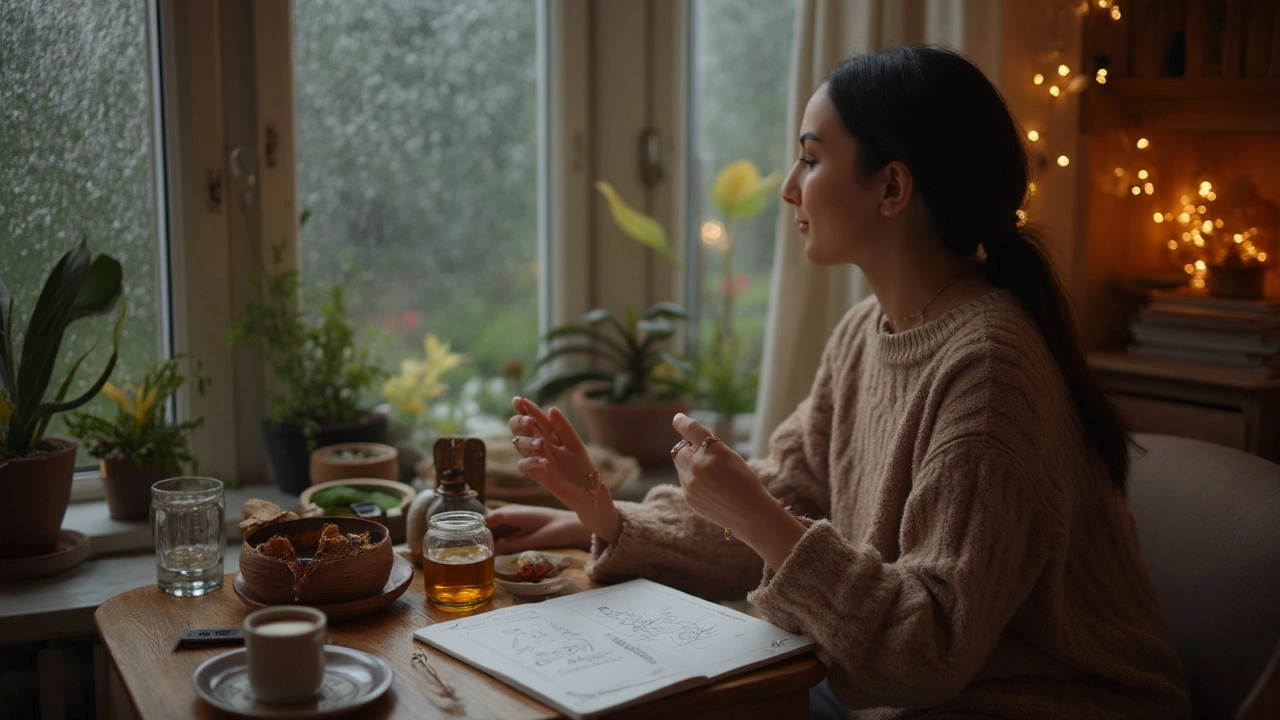You want a self-care ritual that actually fits your life and works fast. Champissage-better known as Indian head massage-hits that sweet spot. It eases tension, soothes headaches, and settles your nervous system in 10-20 minutes. No yoga mat. No fancy gear. Just your hands, a chair, and a little know‑how. Here’s what’s real: it won’t fix every problem under the sun, but it can give you calmer shoulders, clearer headspace, better sleep, and even nudge hair health when you keep at it. I’ll show you how, what to expect with a pro, and smart ways to make it a weekly habit.
TL;DR: Why Champissage belongs in your routine
- It’s quick and low effort. Most people feel calmer and less tight in 10-15 minutes.
- Benefits you can notice: lighter head, looser neck/shoulders, fewer tension headaches, warmer hands and feet, easier sleep.
- Evidence snapshot: Massage meta-analyses show meaningful drops in stress hormones and anxiety; small studies on scalp massage report improved hair thickness over months and short-term blood pressure reductions.
- You don’t need to disrobe. It’s done seated, over clothes; oil is optional.
- Great on non-wash hair days: go oil-free, or use a tiny amount and keep it to the scalp.
- Cost: a professional 25-45 minute session typically runs less than a full-body massage. DIY costs nothing.
- Safety: Avoid if you have active skin infections, recent head/neck injury, or uncontrolled blood pressure. Skip heavy pressure if pregnant or if you get migraines triggered by touch.
Step-by-step: Do-it-yourself Indian head massage (10-20 minutes)
Think of this as a friendly blueprint. Use a timer if it helps. Scale the pressure 0-10 (0 = barely touching, 10 = sharp pain). Stay between 3-6. If anything feels nervy, dizzy, or wrong-back off.
-
Champissage setup (1 minute)
- Sit tall on a chair, feet flat. Drop your shoulders. Unclench your jaw.
- Take 3 slow breaths: inhale 4, exhale 6. This tells your nervous system “we’re safe.”
- Oil is optional. If you use it, warm 1 teaspoon between your palms. Jojoba for fine hair, coconut or almond for dry, sesame for a warming feel. If you have nut allergies, skip nut oils.
-
Neck and shoulder melt (3 minutes)
- Thumb-walk up the base of your skull (suboccipitals) from center to behind the ears. Small circles, pressure 4/10.
- Pinch-and-roll the muscle on top of your shoulder (upper trapezius). Squeeze, hold 3 seconds, release. Do 5-8 times each side.
- Stretch: ear to shoulder, hold 10 seconds; chin to chest, hold 10 seconds. Keep it gentle.
-
Scalp glide (3-5 minutes)
- Place your fingertips along your hairline. Press, make tiny circles, and move back like you’re shampooing-slow, deliberate.
- Cover the top, sides, and crown. Spend extra time on tender spots. If you used oil, keep movements smooth to prevent hair breakage.
- For a deep calm, add temple circles: pads of index and middle fingers, slow circles for 60-90 seconds.
-
Frontal defog (2 minutes)
- Place three fingers above each eyebrow. Press inward and up toward your hairline for 5 seconds, then glide back. Repeat 6-8 times.
- Pinch the bridge of your nose lightly and release along your brows. Great if screens fry your focus.
-
Ear and jaw reset (2 minutes)
- Massage around the ears where jaw and skull meet. Tiny circles. This area sneaks in a lot of stress.
- With your mouth slightly open, trace small circles along your jawline from chin to ear. Keep pressure at 3-4/10.
-
Finish and ground (1 minute)
- Place both hands on your crown and hold still for 20-30 seconds. Breathe out longer than you breathe in.
- Light fingertip drum-taps around the scalp, then smooth down your neck and shoulders.
Quick heuristics you’ll actually remember:
- 5-5-5 rule: 5 minutes scalp, 5 neck/shoulders, 5 for temples and jaw when you’re tight on time.
- Breathe 4-6: inhale 4 seconds, exhale 6 seconds during the whole session.
- Good pain vs bad pain: warm/ache = okay; sharp, zappy, or dizzy = stop.
- Oil math: fine hair 1/2 tsp; thick/coily hair 1-2 tsp; very short hair often needs none.

Examples you can copy: routines, what a pro session feels like, and a data snapshot
Three realistic ways to slot this into your week, depending on your life and hair situation.
-
Desk worker, zero time:
- Every weekday at 3 p.m., do a 7-minute routine: 2 minutes neck, 3 minutes scalp, 2 minutes temples/brows. No oil. Works over styled hair without wrecking it.
-
Sunday reset, hair wash day:
- Before your shower, warm 1 tsp oil. 12-15 minutes whole head and neck. Shampoo twice. Expect softer roots and calmer sleep.
-
Headache-prone, evenings:
- Every other night, 10 minutes focused on base of skull, temples, and jaw. Keep lights low. Add a heat pack to shoulders for 5 minutes first.
What a professional session is like:
- Duration: usually 25-45 minutes. You stay clothed. You’ll sit on a chair or kneel with head support.
- Flow: shoulders and neck first, then scalp and temples, often finishing with a short face massage. Pressure is tailored to you.
- Oils: sesame, coconut, or herbal blends are common; tell them about allergies or if you want oil-free.
- Aftercare: drink water, avoid heavy workouts for 1-2 hours, wash hair if oiled after 30-60 minutes (or leave overnight if that’s your thing).
Evidence, kept simple:
- A meta-analysis (Field, 2005) across massage studies showed average cortisol drops around 31% and anxiety/depression reductions-useful for stress relief.
- A small Japanese study (Koyama et al., 2016) found daily scalp massage increased hair thickness after 24 weeks, likely from mechanical stimulation of dermal cells.
- Small randomized trials of head/scalp massage report short-term reductions in blood pressure and headache intensity. Effects build with regular practice.
- Massage has moderate effects on sleep quality in multiple populations (pooled analyses in sleep and anxiety research).
| Outcome | Typical Change | Time Frame | Evidence Notes |
|---|---|---|---|
| Stress hormone (cortisol) | ~30% average reduction | Immediately to hours after sessions | Massage meta-analyses (e.g., Field, 2005) |
| Anxiety and perceived stress | Moderate decrease | Single session; stronger over weeks | Multiple massage reviews |
| Headache intensity (tension-type) | ~30-40% short-term reduction | Within 24 hours of session | Small RCTs on head/scalp massage |
| Blood pressure (systolic) | ~4-8 mmHg drop | Immediately to 1 hour | Small clinical trials |
| Hair thickness | ~10% increase | 12-24 weeks daily massage | Koyama et al., 2016 (pilot data) |
| Sleep quality | Moderate improvement | After several sessions | Massage therapy meta-analyses |
What this means for you: expect quick calm and softer shoulders right away; headaches may back off the same day; hair benefits show up if you’re consistent for months.
Checklists, pro tips, and smart comparisons
Make-or-break checklist before you start:
- Yes, go ahead if: stress feels high, your shoulders are tight, screens fry your focus, or sleep is patchy.
- Get medical okay first if: you have uncontrolled blood pressure, recent concussion/whiplash, severe migraines, or neck instability.
- Skip today if: you have a fever, active scalp/skin infection, open wounds, or a sunburned scalp.
- Allergies? Use fragrance-free, nut-free oils or go dry.
How to choose a practitioner:
- Training: ask for certification in Indian head massage or equivalent massage credential plus specific scalp/neck training.
- Pressure control: they should check in often and adapt to your comfort.
- Hygiene: clean hands, fresh linens/towels, clear consent about using oil.
- Red flags: neck wrenching, pushing through sharp pain, dismissing your medical history.
Make it stick: tiny habits
- Anchor it to something you already do: kettle boils? Two minutes of temple circles. Waiting for a download? Thumb-walk your neck.
- Use a visual cue: keep a small bottle of oil near your shampoo as a Sunday reminder.
- Track 4 sessions, not perfection: aim for 4 short sessions each week; anything more is a bonus.
Comparing your options: when Champissage wins-and when another massage might be better
- Pick Champissage if: you want seated, clothes-on relaxation; your neck/shoulders/temples are the main problem; you’re seeking quick stress relief or fewer tension headaches.
- Pick Swedish or relaxation massage if: you want full-body calm or are new to touch and want a gentler start.
- Pick deep tissue if: you have stubborn knots in back/hips and tolerate firmer pressure-not ideal for headaches alone.
- Pick reflexology or foot massage if: you’re touch-sensitive on the head or want to protect a fresh blowout or extensions.
- Pick craniosacral therapy if: you want very light touch focused on subtle nervous system shifts and you’re okay with a different feel.
Money/time math you can live with:
- Budget version: DIY 10 minutes, three times a week; pro session once a month as a reset.
- Mid-range: pro session every 2 weeks plus two DIY mini-sessions weekly.
- Max care: weekly pro sessions during stressful seasons, taper later.
Hair and skin notes:
- Fine, oily hair: go dry or use a pea-sized amount; keep oil on scalp, not mid-lengths.
- Thick/coily hair: pre-shampoo oil can be lovely; try sectioning and massaging each quadrant.
- Sensitive skin: patch-test any oil behind your ear for 24 hours.
- Extensions or protective styles: work along the hairline and between braids/tracks; avoid tugging.

FAQ, next steps, and troubleshooting
FAQ
-
How often should I do it?
Short DIY: 3-5 times a week is great. Pro sessions: weekly during high stress, then every 2-4 weeks.
-
Will it help migraines?
Some people get relief; others are touch-sensitive during or before an attack. If touch triggers migraines for you, skip during the prodrome and keep pressure very light between attacks-ask your clinician.
-
Can it help hair growth?
It can support scalp health and, in small studies, hair thickness with daily practice over months. It’s not a cure for medical hair loss. Pair it with medical care if shedding is new or heavy.
-
Do I need oil?
No. Oil adds glide and a soothing ritual, but dry techniques work well and are office-friendly.
-
Is it safe in pregnancy?
Usually, yes-with lighter pressure, no strong neck traction, and fragrance-free oils. If you’re high-risk, get medical clearance first.
-
What if I get sore after?
Mild tenderness is normal the next day. Hydrate, use a warm compress, and lower pressure next time. Sharp pain, dizziness, or visual changes? Seek care.
Troubleshooting by scenario
-
I feel dizzy during neck work.
Sit more upright, reduce pressure to 2-3/10, and slow your head movements. Skip any quick side-bending. If dizziness persists, stop and check in with a clinician.
-
My scalp is tender everywhere.
Use feather-light pressure and focus on breath and temples. Try shorter, more frequent sessions (3-5 minutes) and build up slowly.
-
My hair gets greasy.
Go oil-free on weekdays. If you use oil, keep it to the scalp, and shampoo twice. Dry shampoo at the roots can help on day two.
-
I don’t have time.
Pair it with something you always do: two minutes during kettle boil, five minutes pre-shower on Sundays. Consistency beats duration.
-
Headaches don’t change.
Try a heat pack on shoulders for 5-10 minutes first, add jaw work, hydrate, and check your posture. If headaches are frequent or severe, see a clinician to rule out other causes.
Next steps
- Week 1: two 10-minute DIY sessions. Notice when you feel best-morning, afternoon, or night.
- Week 2: add a third short session or book one pro treatment to learn pressure and flow.
- Week 3-4: aim for a simple rhythm: three DIY minis weekly + one longer Sunday reset.
- Quarterly: re-evaluate goals-fewer headaches, better sleep, or just sanity time? Adjust frequency accordingly.
One last nudge: your brain loves reliable rituals. Keep Champissage short, simple, and anchored to something you already do, and it’ll become that quiet, non-negotiable pause you actually look forward to.
